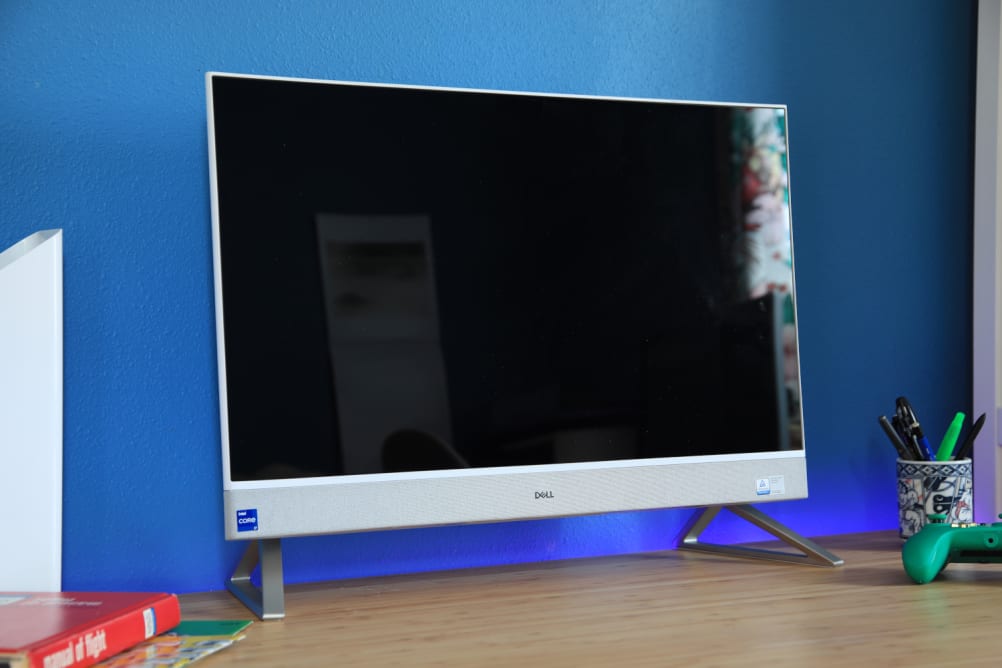Pros
-
Attractive design
-
Great audio quality
-
Plenty of wired and wireless connectivity
Cons
-
Basic performance
-
1080p display doesn’t impress
-
Disappointing bundled peripherals
About the Dell Inspiron 27 7710
Here are the specs of the desktop we tested:
- Processor: Intel Core i7-1255U
- Graphics: Intel Iris Xe
- RAM: 12GB DDR4
- Storage: 512GB PCIe NVMe SSD
- Wireless connectivity: Wi-Fi 6E, Bluetooth 5.2
- Wired connectivity: 1x USB-C 3.2 Gen 2 (side), 3x USB-A 3.1 Gen 1, 1x USB-A 3.1 Gen 2, HDMI 1.4 in, HDMI 1.4 out, Ethernet, 3.5mm audio, SDcard reader.
- Webcam: 1080p webcam with privacy shutter and microphone
- Weight: 16.23 pounds
- Size: 17.85 x 24.2 x 7.9 inches
- MSRP: $1,089.99
The Inspiron 27 model we reviewed is a modest upgrade over the base model, which starts at $880 for an Intel Core i5-1235U processor and 8GB of RAM. Further upgrades can add up to 32GB of RAM as well as Nvidia MX550 discrete graphics, which increases the price to a maximum of $1,350.
What would you add to your wardrobe if you had a little extra money? We're giving away two $250 Nordstrom gift cards, so let's find out. Enter to win between now and Sept. 30, 2022.
What we like
Attractive design at an affordable price
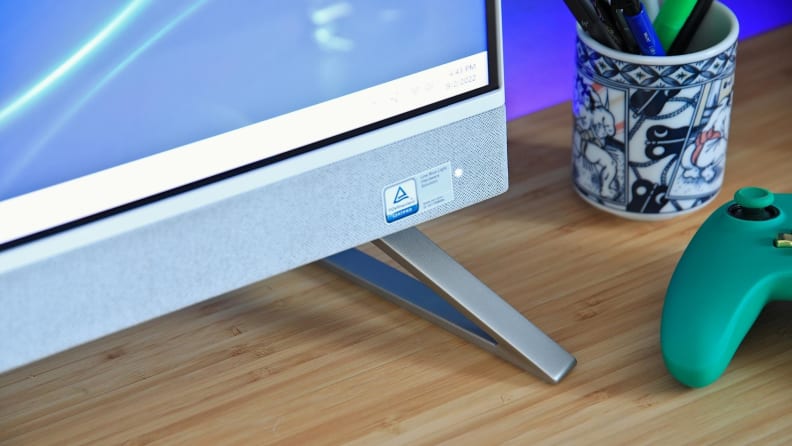
For the price, you get all of the essentials you seek in a desktop, and then some.
The Dell Inspiron 27 starts below $1,000, which is reasonably affordable for a modern all-in-one computer. Our as-tested model, with several upgrades, landed at $1,089.99. That’s not a high price for a modern all-in-one, yet Dell avoids any noticeable compromises and shortcuts in the desktop’s design; it looks fantastic.
Dell opts for a simple, thin-bezel display with a fabric-covered chin that houses the speakers. It’s an attractive design that should fit in nicely with most home office setups. I especially like Dell’s use of a warm, white color palette and fabric touch points, which stands in contrast to the silver, black, business-like look of Lenovo’s IdeaCentre and Acer’s C-series.
It holds up on closer inspection. The fabric used across the Dell Inspiron 27’s chin feels soft and pleasant. Spin it around and you’ll find a sturdy white matte plastic rear panel with a chrome Dell logo. Most materials are plastic, but the legs are solid metal and feel extremely durable.
It’s hard to see how Dell could improve on this design, especially at this price. Every touch point is inviting, every panel durable, and every seam is slim or kept out of sight. Dell’s only serious competition is HP, which uses a similar design for its Pavilion All-in-One. The most obvious difference is the stand; Dell opts for wide, TV-style legs, while HP uses a traditional square monitor base.
The bundled soundbar is loud and enjoyable
The pair of speakers beneath the Dell Inspiron 27’s fabric-covered chin are loud, deliver respectable bass, and sound clear even at high volume.
Music sounds impressive thanks to the speakers’ bass which, in turn, provides room for the upper and mid-range to express themselves without becoming muddled. Vocals and beats come through at once without one overwhelming the other.
The speakers sound great in dialogue-heavy content such as podcasts or YouTube videos. They provide enough volume to fill a large room with sound and offer the range to handle a variety of vocal styles.
This is not an “audiophile” experience, however. The speakers have a limited sound stage, which is noticeable when listening to tracks that should be broad and dynamic, such as live recordings of classical music. Bass is present, but it’s not going to shake the pictures off your walls.
With those limits, however, it’s a good experience. It’s great to hear quality audio from a mid-range all-in-one, as computers in this price range often get by with merely passable sound.
Excellent wired and wireless connectivity
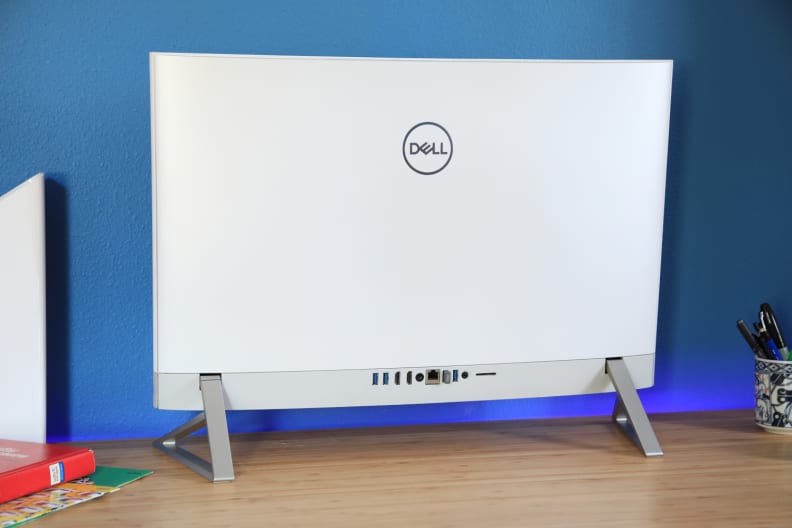
A decent upgrade over the last model.
The Dell Inspiron 27 doesn’t skimp on physical connectivity. It includes a total of four USB-A ports, plus one USB-C port, Ethernet, a 3.5mm audio jack, and an SDcard Reader.
HDMI-in and HDMI-out are included, as well. You can connect an external monitor or use the Dell Inspiron 27’s display as a monitor for a connected device, such as a game console or streaming stick.
Some competitors, like the HP Pavilion 27 and Lenovo IdeaCentre 5i offer similar wired connectivity. Still, the range of ports on the Inspiron 27 is excellent for the price.
I do wish the ports were in better locations. The USB-C port is alone on the Inspiron 27’s flank. The Lenovo IdeaCentre 5i, by comparison, offers easy access to two USB-A ports, the audio jack, and an SDcard reader.
The Inspiron 27 supports the latest Wi-Fi 6E and Bluetooth 5.2 standards. I expect most people looking to purchase the Inspiron 27 will not yet have a Wi-FI 6E router and may not own Bluetooth 5.2 wireless headphones, as both standards are new. Still, the inclusion of these high-end wireless features helps future-proof the PC.
It’s calm under stress
Dell equips the Inspiron 27 with a mobile chipset and Intel’s Core i7-1255U processor. It’s meant for laptops, so it sips power and generates as little heat as possible.
The Inspiron 27 is much larger than a laptop, of course, which keeps the chip cool with zero fuss. The always-active fan is whisper-quiet and is still difficult to hear in an extremely quiet room. Even the slightest background noise, like a fan in another room or a nearby road, will obscure it. The fan kicks up slightly under full load but remains indistinct.
This relaxed operation is reflected in processor temperatures, which reach a peak of 122 degrees Fahrenheit (50 degrees Celcius) in a 30-minute Cinebench R23 loop. That’s much, much cooler than a typical laptop, which may exceed 190 F (87.7 C). External temperatures are also cool, reaching a peak of 87 F (30.5 C) in two small hotspots. This warmth is hardly noticeable to the touch.
What we don’t like
Performance is basic, at best
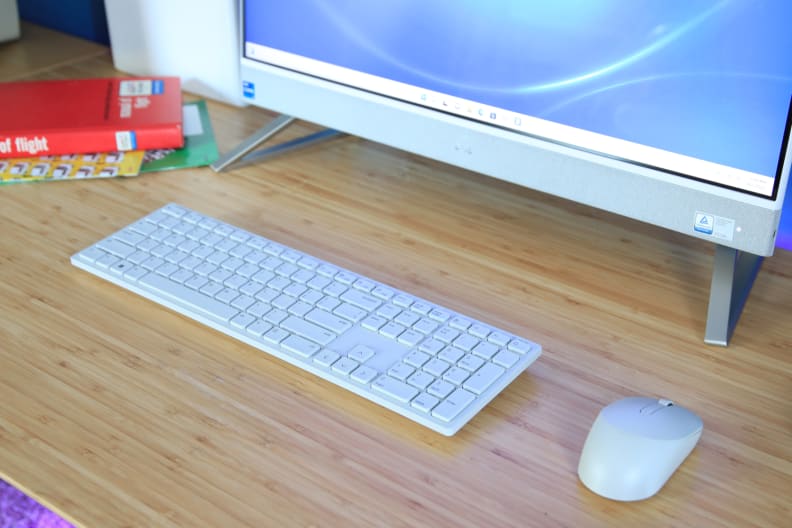
For better performance, a few upgrades may be required.
The Intel Core i7-1255U is a 10-core processor which, on paper, sounds great. Only two of those cores are Performance cores, however. The rest are Intel’s far slower Efficient cores, and this limits performance in demanding workloads.
The Dell Inspiron 27 achieves a single-threaded score of 1570 in Geekbench 5. That’s a strong score, defeating the Core i5-12400 in the Acer Aspire TC desktop, which scored 1446. It also beats mid-range mobile AMD Ryzen processors. The Lenovo Yoga 6 laptop, powered by an AMD Ryzen 5 5500U, scored just 1075 in this test.
Unfortunately, the Core i7-1255U falls behind in multi-threaded workloads, reaching just 5132 in Geekbench 5’s multi-threaded test. That’s far behind the Acer Aspire TC’s score of 7284, and merely ties the Lenovo Yoga 6, which scored 5105.
Cinebench R23 reflects this with the Inspiron 27 earning a multi-threaded score of 4833. The Acer Aspire TC was drastically quicker, scoring 10936. The Lenovo Yoga 6 laptop also wins with a score of 5682. This reflects the Core i7-1255U’s heavy reliance on Efficient cores, which lack the compute performance to do well in heavy multi-threaded tasks.
The Inspiron 27’s graphics performance is also sub-par, as it relies solely on Intel Iris Xe integrated graphics. It reached a 3DMark Time Spy score of just 1120. The Lenovo Yoga 9 with Radeon integrated graphics hit a similar score of 1043, while the Acer Aspire TC scored 1895. The Acer Nitro N50, a barebones gaming desktop with GTX 1650 discrete graphics, scored 8069.
This means the Inspiron 27 can only handle the most basic 3D games, and even then it may be necessary to dial settings down to medium for smooth gameplay at 60 frames per second. An upgrade to Nvidia MX550 discrete graphics is available, but only in top-end models starting at $1,350 and only with 2GB of video memory. Those who want to game on an all-in-one are better off with a model that at least has Nvidia GTX 1650 graphics, such as the HP Envy 34 or Dell Optiplex 5490.
The Inspiron 27 is not slow in day-to-day tasks but is not suited to more demanding applications like photo or video editing. It’s also a terrible choice for games. This will limit its appeal to those who only use a computer for document editing, web browsing, and retro gaming.
And some of Dell’s competitors have an edge. A similarly priced HP Pavilion 27 can be purchased with an AMD Ryzen 7 5700U processor that will beat the Inspiron 27 in multi-threaded software.
Disappointing 1080p display
All Dell Inspiron 27 models have a 1080p display. The base model has a matte, non-touch screen, but the model I tested had a glossy touchscreen upgrade.
It makes a good first impression. The screen looks vivid at first glance and the glossy coat provides a sense of depth and drama that’s hard to replicate on a matte screen. The gloss creates glare, however, so the Inspiron 27 can be difficult to view in a bright, sunlit room.
But there is an issue with the display: the “screen door effect,” which results in faint, visible lines across the display. This is caused by a gap between pixels that’s large enough to be noticeable. The Dell Inspiron 27 suffers a mild version of this issue, so everyone might not see it, but those that do will most likely find it distracting.
1080p isn’t a high resolution for a 27-inch display, either, so the pixel density is an issue. Fonts can appear blocky and jagged at times and streaming video can look soft.
The Inspiron 27’s display is on par with what I expect in this price bracket. All-in-one computers with 1440p or 4K resolution are several hundred dollars more expensive. Still, it will quickly feel dated as the world slowly, but surely, moves on to 4K, OLED, Mini-LED, and other new display technologies.
Mediocre bundled accessories
Dell includes a wireless keyboard and mouse with the Inspiron 27 that connects via a bundled wireless USB dongle. They work from the moment the dongle is plugged in and require no additional setup or installation.
The mouse is the better of the pair. It’s a simple and comfortable, compact device with three buttons and a scroll wheel. Nothing special, but it did the job. An entry-level Logitech mouse, like the M325 Wireless Mouse, is a better choice with superior materials and more buttons—but the bundled mouse is fine.
I can’t say the same about the keyboard. It uses a rubber dome membrane that creates a squishy, vague key feel. This makes the keyboard uncomfortable to use for long periods, as it’s hard to know how far a key should be pressed to be activated.
Sub-par bundled peripherals are common among mid-range, all-in-one computers. Still, it would be better to have a good keyboard in the box; immediately tossing it out in favor of another new keyboard is a waste of money, cardboard, and plastic.
A 1080p webcam is included, as well, and retracts behind the display when not in use. 1080p video sounds great but the webcam’s video quality is not good in practice. The video is soft, grainy, and fuzzy. The microphone captures clear dialogue but allows too much background noise. This is once again excused by the competition, as it’s hard to find a notably better webcam in this price bracket.
Should you buy the Dell Inspiron 27 7710 All-in-One?
Yes, it’s is a great, everyday PC
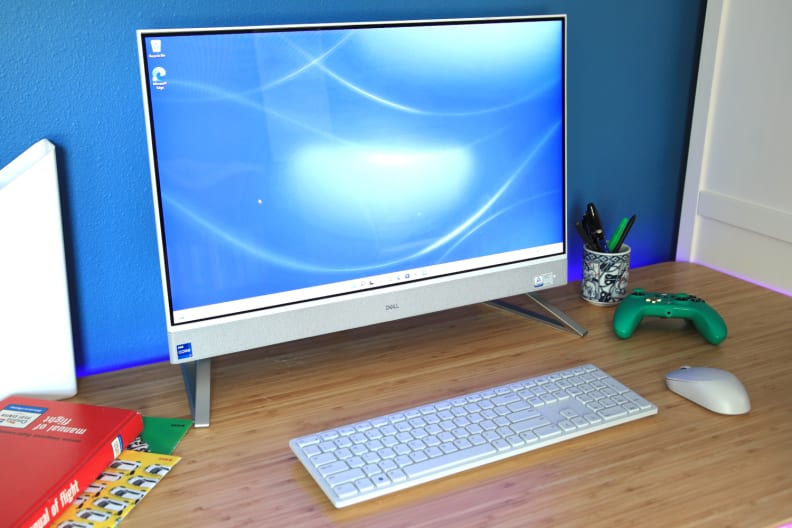
It's perfect for working and browsing!
Dell’s Inspiron 27 All-in-One is an excellent choice if you want a simple, attractive, versatile desktop for basic tasks. It will look great in both a home office or living room, isn’t overly large, and runs quietly. There’s plenty of connectivity for both wired and wireless peripherals and even HDMI-in for an external video source, such as a game console.
The Inspiron 27 performance has limits, though. This is not a good choice for content creators of any level of experience. It’s also a terrible choice for PC gaming. The 1080p display also fails to impress which, in turn, can make streaming video look dull and soft—especially when compared to a 4K TV or monitor.
These flaws are common to the Inspiron 27’s competitors, however, including the HP Pavilion 27 and Acer’s C-Series. Mid-range all-in-ones are, as a category, not designed for demanding tasks or gaming. They are practical PCs for people who want a great, out-of-box experience with minimal fuss. That’s what the Inspiron 27 delivers, and it does so with class-leading style at a competitive price.
Meet the tester
Matthew S. Smith is a veteran tech journalist and general-purpose PC hardware nerd. Formerly the Lead Editor of Reviews at Digital Trends, he has over a decade of experience covering PC hardware. Matt often flies the virtual skies in Microsoft Flight Simulator and is on a quest to grow the perfect heirloom tomato.
Checking our work.
Our team is here to help you buy the best stuff and love what you own. Our writers, editors, and experts obsess over the products we cover to make sure you're confident and satisfied. Have a different opinion about something we recommend? Email us and we'll compare notes.
Shoot us an email